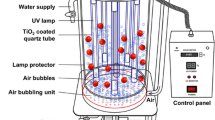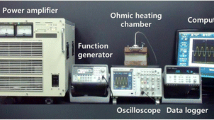Abstract
The purpose of this study was to investigate the effect of combined treatments using TiO2-UV photocatalysis (TUVP) and high hydrostatic pressure (HHP) on inactivation of microorganisms in commercial apple juice as model liquid food. A synergistic effect was observed for combined treatments to inactivate microorganisms. Gram-positive bacteria, Listeria monocytogenes and Staphylococcus aureus, were completely inactivated from initial loads of 7.1 and 6.7 log CFU/mL, respectively, when treated with a combination of TUVP (8.45 J/cm2) and HHP (500 MPa). In contrast, reductions of only 4.8 log CFU/mL (L. monocytogenes) and 2.4 log CFU/mL (S. aureus) were achieved with 500 MPa HHP alone. Gram-negative bacteria, Escherichia coli O157:H7 and Salmonella Typhimurium, were reduced by 7.1 and 7.2 log CFU/mL, respectively, after a combined treatment using 8.45 J/cm2 TUVP and 600 MPa (E. coli) or 400 MPa (S. Typhimurium) HHP which were significantly higher than the effects of HHP alone. A 6.2 log CFU/mL reduction in Saccharomyces cerevisiae count was monitored after treatment with a combination of 8.45 J/cm2 TUVP and 500 MPa HHP whereas even 600 MPa alone could not achieve complete S. cerevisiae inactivation. Combined treatments (TUVP + HHP) were more effective for microbial inactivation than alone treatments. Scanning electron microscopic images of microorganisms showed highly deformed morphologies after TUVP + HHP treatment. In conclusion, pretreatment of commercial apple juice using TUVP before HHP processing results in better disinfection and may assure complete disinfection.


Similar content being viewed by others
References
Bayındırlı, A., Alpas, H., Bozoğlu, F., & Hızal, M. (2006). Efficiency of high pressure treatment on inactivation of pathogenic microorganisms and enzymes in apple, orange, apricot and sour cherry juices. Food Control, 17, 52–58.
Benabbou, A. K., Derriche, Z., Felix, C., Lejeune, P., & Guillard, C. (2007). Photocatalytic inactivation of Escherichia coli: effect of concentration of TiO2 and microorganism, nature, and intensity of UV irradiation. Appl Catal B Environ, 76, 257–263.
Chai, C., Lee, J., Lee, Y., Na, S., & Park, J. (2014). A combination of TiO2–UV photocatalysis and high hydrostatic pressure to inactivate Bacillus cereus in freshly squeezed Angelica keiskei juice. LWT Food Sci Technol, 55, 104–109.
Ferrario, M., Alzamora, S. M., & Guerrero, S. (2015). Study of the inactivation of spoilage microorganisms in apple juice by pulsed light and ultrasound. Food Microbiol, 46, 635–642.
Garcia-Gonzalez, L., Geeraerd, A. H., Elst, K., Van Ginneken, L., Van Impe, J. F., & Devlieghere, F. (2009). Influence of type of microorganism, food ingredients and food properties on high-pressure carbon dioxide inactivation of microorganisms. Int J Food Microbiol, 129, 253–263.
Gayán, E., Serrano, M. J., Raso, J., Álvarez, I., & Condón, S. (2012). Inactivation of Salmonella enterica by UV-C light alone and in combination with mild temperatures. Appl Environ Microbiol, 78, 8353–8361.
Ghafoor, K., Kim, S. O., Lee, D. U., Seong, K., & Park, J. (2012). Effects of high hydrostatic pressure on structure and colour of red ginseng (Panax ginseng). J Sci Food Agric, 92, 2975–2982.
Guerrero-Beltrán, J. A., & Barbosa-Cánovas, G. V. (2005). Reduction of Saccharomyces cerevisiae, Escherichia coli and Listeria innocua in apple juice by ultraviolet light. J Food Process Eng, 28, 437–452.
Hashimoto, K., Irie, H., & Fujishima, A. (2005). TiO2 photocatalysis: a historical overview and future prospects. Jpn J Appl Phys, 44, 8269–8285.
Ireland, J. C., Klostermann, P., Rice, E. W., & Clark, R. M. (1993). Inactivation of Escherichia coli by titanium dioxide photocatalytic oxidation. Appl Environ Microbiol, 59, 1668–1670.
Jordan, S. L., Pascual, C., Bracey, E., & Mackey, B. M. (2001). Inactivation and injury of pressure-resistant strains of Escherichia coli O157 and Listeria monocytogenes in fruit juices. J Appl Microbiol, 91, 463–469.
Keyser, M., Műller, I. A., Cilliers, F. P., Nel, W., & Gouws, P. A. (2008). Ultraviolet radiation as a non-thermal treatment for the inactivation of microorganisms in fruit juice. Innovative Food Sci. Emerg. Technol., 9, 348–354.
Kim, S., Ghafoor, K., Lee, J., Feng, M., Hong, J., Lee, D. U., & Park, J. (2013). Bacterial inactivation in water, DNA strand breaking, and membrane damage induced by ultraviolet-assisted titanium dioxide photocatalysis. Water Res, 47, 4403–4411.
Kopecká, M., Phaff, H. J., & Fleet, G. H. (1974). Demonstration of a fibrillar component in the cell wall of the yeast Saccharomyces cerevisiae and its chemical nature. J Cell Biol, 62, 66–76.
Mañas, P., & Pagán, R. (2005). Microbial inactivation by new technologies of food preservation. J Appl Microbiol, 98, 1387–1399.
Maness, P. C., Smolinski, S., Blake, D. M., Huang, Z., Wolfrum, E. J., & Jacoby, W. A. (1999). Bactericidal activity of photocatalytic TiO2 reaction: toward an understanding of its killing mechanism. Appl Environ Microbiol, 65, 4094–4098.
Marx, G., Moody, A., & Bermúdez-Aguirre, D. (2011). A comparative study on the structure of Saccharomyces cerevisiae under nonthermal technologies: high hydrostatic pressure, pulsed electric fields and thermo-sonication. Int J Food Microbiol, 151, 327–337.
Mihajlovic, B., Dixon, B., Couture, H., & Farber, J. (2013). Qualitative microbiological risk assessment of unpasteurized fruit juice and cider. Int Food Risk Anal J, 3, 1–19.
Mohideen, F. W., Solval, K. M., Li, J., Zhang, J., Chouljenko, A., Chotiko, A., Prudente, A. D., Bankston, J. D., & Sathivel, S. (2015). Effect of continuous ultra-sonication on microbial counts and physico-chemical properties of blueberry (Vaccinium corymbosum) juice. LWT Food Sci Technol, 60, 563–570.
Ogihara, H., Yatuzuka, M., Horie, N., Furukawa, S., & Yamasaki, M. (2009). Synergistic effect of high hydrostatic pressure treatment and food additives on the inactivation of Salmonella enteritidis. Food Control, 20, 963–966.
Patterson, M. F. (2005). Microbiology of pressure-treated foods. J Appl Microbiol, 98, 1400–1409.
Patterson, M. F., McKay, A. M., Connolly, M., & Linton, M. (2012). The effect of high hydrostatic pressure on the microbiological quality and safety of carrot juice during refrigerated storage. Food Microbiol, 30, 205–212.
Pilavtepe-Çelik, M., Balaban, M. O., Alpas, H., & Yousef, A. E. (2008). Image analysis based quantification of bacterial volume change with high hydrostatic pressure. J Food Sci, 73, 423–429.
Raso, J., & Barbosa-Cánovas, G. V. (2003). Nonthermal preservation of foods using combined processing techniques. Crit Rev Food Sci Nutr, 43, 265–285.
Reineke, K., Mathys, A., Heinz, V., & Knorr, D. (2013). Mechanisms of endospore inactivation under high pressure. Trends Microbiol, 21, 296–304.
San-Martín, M. F., Barbosa-Cánovas, G. V., & Swanson, B. G. (2002). Food processing by high hydrostatic pressure. Crit Rev Food Sci Nutr, 42, 627–645.
Serment-Moreno, V., Fuentes, C., Barbosa-Cánovas, G., Torres, J. A., & Welti-Chanes, J. (2015). Evaluation of high pressure processing kinetic models for microbial inactivation using standard statistical tools and information theory criteria, and the development of generic time–pressure functions for process design. Food Bioprocess Technol., 8, 1244–1257.
Song, H. P., Byun, M. W., Jo, C., Lee, C. H., Kim, K. S., & Kim, D. H. (2007). Effects of gamma irradiation on the microbiological, nutritional, and sensory properties of fresh vegetable juice. Food Control, 18, 5–10.
Sung, H. J., Song, W. J., Kim, K. P., Ryu, S., & Kang, D. H. (2014). Combination effect of ozone and heat treatments for the inactivation of Escherichia coli O157:H7, Salmonella Typhimurium, and Listeria monocytogenes in apple juice. Int J Food Microbiol, 171, 147–153.
Tarek, A. R., Rasco, B. A., & Sablani, S. S. (2015). Ultraviolet-C light inactivation kinetics of E. coli on bologna beef packaged in plastic films. Food Bioprocess Technol, 8, 1267–1280.
Tran, M. T. T., & Farid, M. (2004). Ultraviolet treatment of orange juice. Innovative Food Sci. Emerg. Technol, 5, 495–502.
Ukuku, D. O., & Geveke, D. J. (2010). A combined treatment of UV-light and radio frequency electric field for the inactivation of Escherichia coli K-12 in apple juice. Int J Food Microbiol, 138, 50–55.
Vega-Gálvez, A., Giovagnoli, C., Pérez-Won, M., Reyes, J. E., Vergara, J., Miranda, M., Uribe, E., & Scala, K. D. (2012). Application of high hydrostatic pressure to aloe vera (Aloe barbadensis Miller) gel: microbial inactivation and evaluation of quality parameters. Innovative Food Sci. Emerg. Technol, 13, 57–63.
Wang, L., Pan, J., Xie, H., Yang, Y., & Lin, C. (2010). Inactivation of Staphylococcus aureus and Escherichia coli by the synergistic action of high hydrostatic pressure and dissolved CO2. Int J Food Microbiol, 144, 118–125.
Yao, J., Zhou, B., Wang, R., Wang, T., Hu, X., Liao, X., & Zhang, Y. (2015). Inactivation of Staphylococcus aureus by high hydrostatic pressure in saline solution and meat slurry with different initial inoculum levels. Food Bioprod. Process., 94, 592–600.
Yoo, S., Ghafoor, K., Kim, S., Sun, Y. W., Kim, J. U., Yang, K., Lee, D., Shahbaz, H. M., & Park, J. (2015). Inactivation of pathogenic bacteria inoculated onto a Bacto™ agar model surface using TiO2-UVC photocatalysis, UVC and chlorine treatments. J Appl Microbiol, 119, 688–696.
Zhao, L., Wang, S., Liu, F., Dong, P., Huang, W., Xiong, L., & Liao, X. (2013). Comparing the effects of high hydrostatic pressure and thermal pasteurization combined with nisin on the quality of cucumber juice drinks. Innovative Food Sci. Emerg. Technol., 17, 27–36.
Acknowledgments
This research was supported by the High Value-added Food Technology Development Program (Grant No. 111139-3), Ministry of Agriculture, Food and Rural Affairs, Republic of Korea.
Conflict of Interest
Authors declare that they have no conflict of interest.
Author information
Authors and Affiliations
Corresponding author
Rights and permissions
About this article
Cite this article
Shahbaz, H.M., Yoo, S., Seo, B. et al. Combination of TiO2-UV Photocatalysis and High Hydrostatic Pressure to Inactivate Bacterial Pathogens and Yeast in Commercial Apple Juice. Food Bioprocess Technol 9, 182–190 (2016). https://doi.org/10.1007/s11947-015-1614-9
Received:
Accepted:
Published:
Issue Date:
DOI: https://doi.org/10.1007/s11947-015-1614-9




